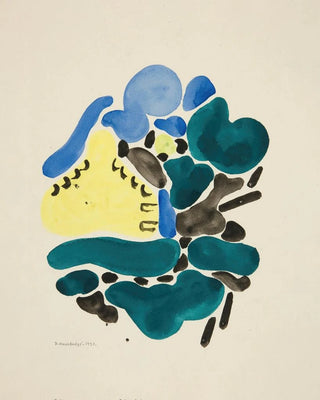Abstract Painting based on floral shapes I - David Kakabadze | Art print


View from behind

Frame (optional)
In the fascinating universe of modern art, some artworks stand out for their ability to transcend time and evoke deep emotions. "Art print based on floral forms I - David Kakabadze" is one of those creations that, through its boldness and delicacy, invites us to attentive contemplation. This piece, imbued with visual poetry, questions our perception of the natural world through an abstract lens, encouraging us to rediscover the beauty of flowers from a new perspective. Kakabadze, with his innovative approach, immerses us in a universe where color and form intertwine to create a unique harmony.
Style and uniqueness of the work
Kakabadze's work is characterized by a daring synthesis of abstraction and figuration. In "Art print based on floral forms I," organic shapes subtly evoke blooming, while moving away from realistic representations. Vibrant colors and flowing lines create a captivating dynamic, where each element seems to dance across the canvas. This piece does not merely depict nature; it interprets it, endowing it with an emotional dimension that resonates with the viewer. The juxtaposition of hues and forms evokes a visual melody, a symphony of sensations that transports us to the heart of a secret garden, where imagination blossoms freely. Kakabadze thus manages to capture the very essence of blooming, while leaving room for each person's personal interpretation.
The artist and his influence
David Kakabadze, an emblematic figure of Georgian art in the early 20th century, made his mark by his commitment to artistic innovation. Influenced by European modernist currents, he developed a unique style that combines tradition and avant-garde. Kakabadze was not only a painter but also an art theorist, deeply reflecting on the place of art in society. His work is nourished by his travels and encounters, integrating elements of Georgian culture while engaging in dialogue with the major artistic movements of his time. Through his creations, he opened the

Matte finish

View from behind

Frame (optional)
In the fascinating universe of modern art, some artworks stand out for their ability to transcend time and evoke deep emotions. "Art print based on floral forms I - David Kakabadze" is one of those creations that, through its boldness and delicacy, invites us to attentive contemplation. This piece, imbued with visual poetry, questions our perception of the natural world through an abstract lens, encouraging us to rediscover the beauty of flowers from a new perspective. Kakabadze, with his innovative approach, immerses us in a universe where color and form intertwine to create a unique harmony.
Style and uniqueness of the work
Kakabadze's work is characterized by a daring synthesis of abstraction and figuration. In "Art print based on floral forms I," organic shapes subtly evoke blooming, while moving away from realistic representations. Vibrant colors and flowing lines create a captivating dynamic, where each element seems to dance across the canvas. This piece does not merely depict nature; it interprets it, endowing it with an emotional dimension that resonates with the viewer. The juxtaposition of hues and forms evokes a visual melody, a symphony of sensations that transports us to the heart of a secret garden, where imagination blossoms freely. Kakabadze thus manages to capture the very essence of blooming, while leaving room for each person's personal interpretation.
The artist and his influence
David Kakabadze, an emblematic figure of Georgian art in the early 20th century, made his mark by his commitment to artistic innovation. Influenced by European modernist currents, he developed a unique style that combines tradition and avant-garde. Kakabadze was not only a painter but also an art theorist, deeply reflecting on the place of art in society. His work is nourished by his travels and encounters, integrating elements of Georgian culture while engaging in dialogue with the major artistic movements of his time. Through his creations, he opened the
12,34 €






